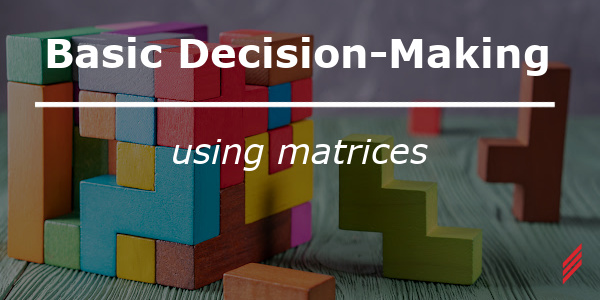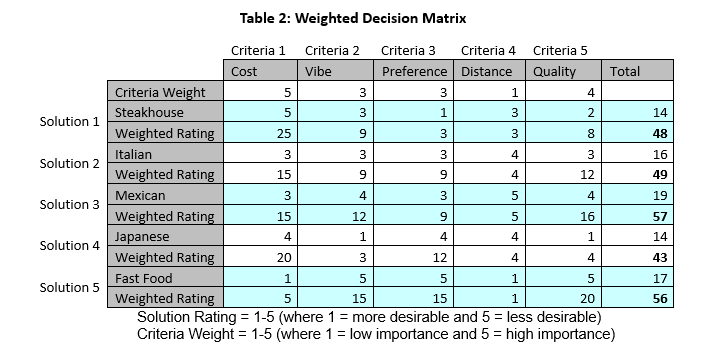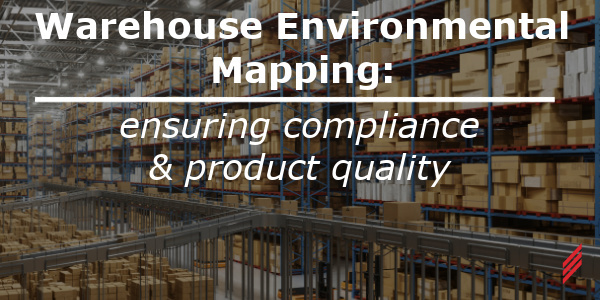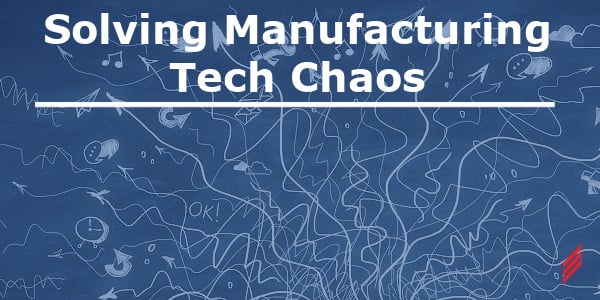Basic Decision-Making Using Matrices
by Frank Abel on Apr 4, 2024 10:30:00 AM

What is a Decision Matrix?
A decision matrix is a decision-making technique that evaluates a set of choices and compares them against a set of criteria. When making a decision matrix, the criteria you compare your options to can be totally up to you. Typically, decision matrices are used in business and can include criteria such as Cost, Return on Investment, Impact on Systems, Ease of Implementation, Value to Customer, ETC. The example below shows how a simple matrix can be made for decisions as small as where to go to dinner (see below).
In the matrix above, the decision we are trying to find a solution for finding a restaurant for dinner. As seen, the various solutions are then compared to different criteria, in this case 5. Making a decision matrix like the one above allows you to see which option would be the best choice given the criteria you develop. In our example, we can see that the Steakhouse or Japanese option would be the best choice for use because it had the lowest total (lower total means more desirable).
What is a Weighted Decision Matrix?
As seen in Table 1, there can sometimes be options in the decision matrix that end with the same totals (Steakhouse and Japanese). This being the case, the matrix didn’t fully help us in our mission to make a clear decision. One way we can possibly get around this is to add another level to our previous decision matrix. This new level will consist of a weight value for each of the criteria being judged. To do this all you need to do is add a weight to each category depending on how that category is important to you. Seen in row 1 of Table 2, a weight value is given to each category. The weight is chosen by the user and is dependent on many different things and it is okay to have the same weights in multiple categories. With the weight of each criteria chosen, you can now calculate the weighted rating for each category for each solution. To do this it is as simple as multiplying the criteria weight by the Solution rating.
In comparing the original decision matrix (seen on the top line of each solution) to the new weighted criteria (row 1), we can find the weighted rating for each of the solutions put forth (bottom line of each solution). In the last column we can total these weighted ratings up and get an idea about which of our choices would be the best for us to pick. As seen by the bolded numbers in Table 2, we found out that the best choice we could make for which restaurant we should go to is actually the Japanese restaurant. Adding a weight system to the original decision matrix allowed us to go from having two possible solutions down to having one solution that we can be confident in. From this example we can see that the Japanese restaurant is the best decision for us. (Note this is an entirely empirical way to make decisions. This does not guarantee that the best choice will be the one you personally wanted to end up with. As seen in the preference column of the tables the steakhouse was the top choice and the Japanese restaurant was almost last, but we can be confident the decision we ended up with is the best for us based on what we inputted.)
As seen above, decision matrices can be an extremely easy and understandable tool to help aid in making simple choices like deciding where to eat. You are also able to design matrices that can be very complex that can tackle tough business/engineering decisions that need more thought before a solution is selected. This blog was designed to give a basic understanding of simple decision matrices, without going into too much depth. There are methods other than weights that can be applied to matrices, such as data normalization and nesting of matrices that can be used to help refine choices as well. There are lots of good resources that go into detail describing these other methods on the Web if interested!
About the Author
Frank Abel works as an Arc Flash Engineer within the Electrical Safety Services team in Hallam’s New York office and has a B.S. in Electrical Engineering from University at Buffalo. He enjoys spending time with his family hanging out with his friends. As well as blacksmithing, mead making, and other hobbies focused on self-reliance.
Read My Hallam Story
About Hallam-ICS
Hallam-ICS is an engineering and automation company that designs MEP systems for facilities and plants, engineers control and automation solutions, and ensures safety and regulatory compliance through arc flash studies, commissioning, and validation. Our offices are located in Massachusetts, Connecticut, New York, Vermont and North Carolina Texas, Florida and our projects take us world-wide.
You May Also Like
These Related Stories

More Than Just Machines: How Relationships Shape Technology

Warehouse Environmental Mapping: Ensuring Compliance & Product Quality




No Comments Yet
Let us know what you think